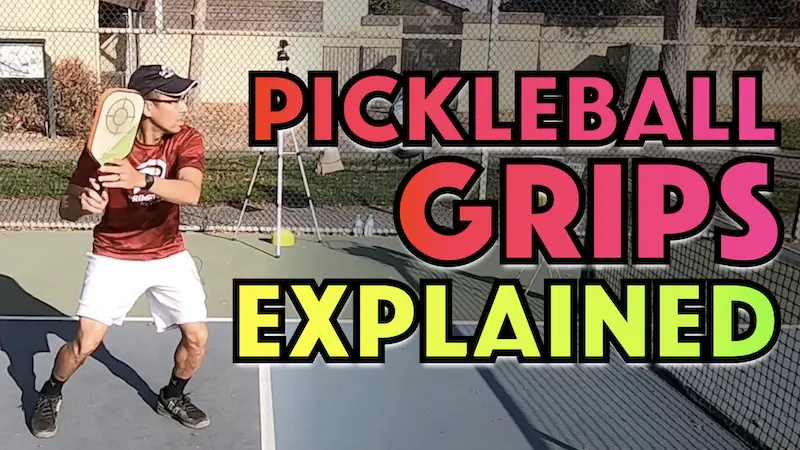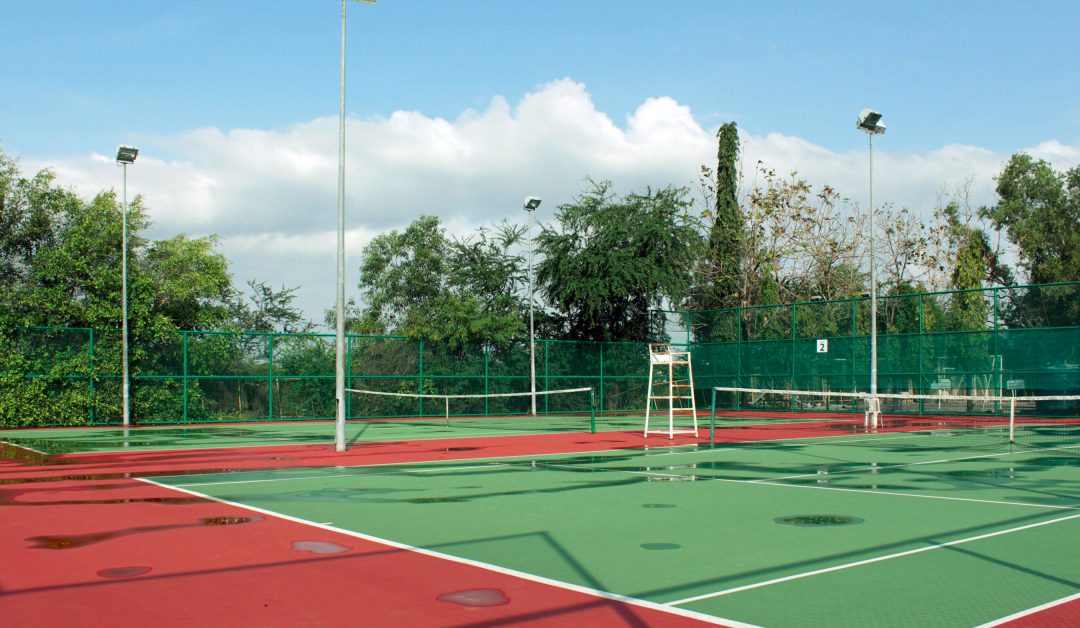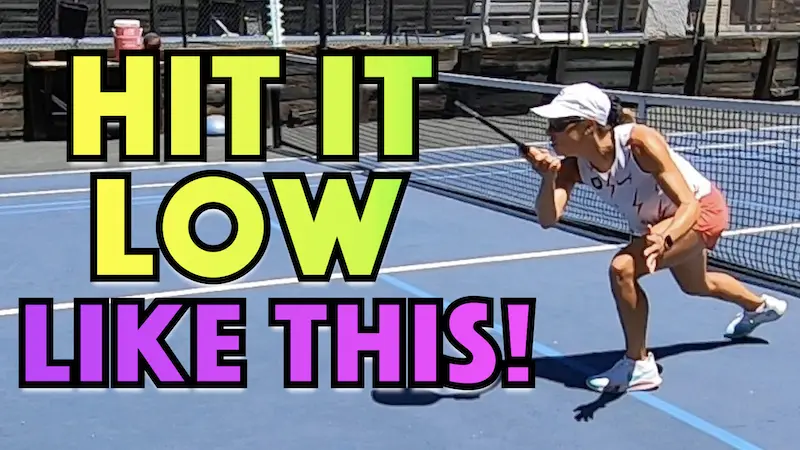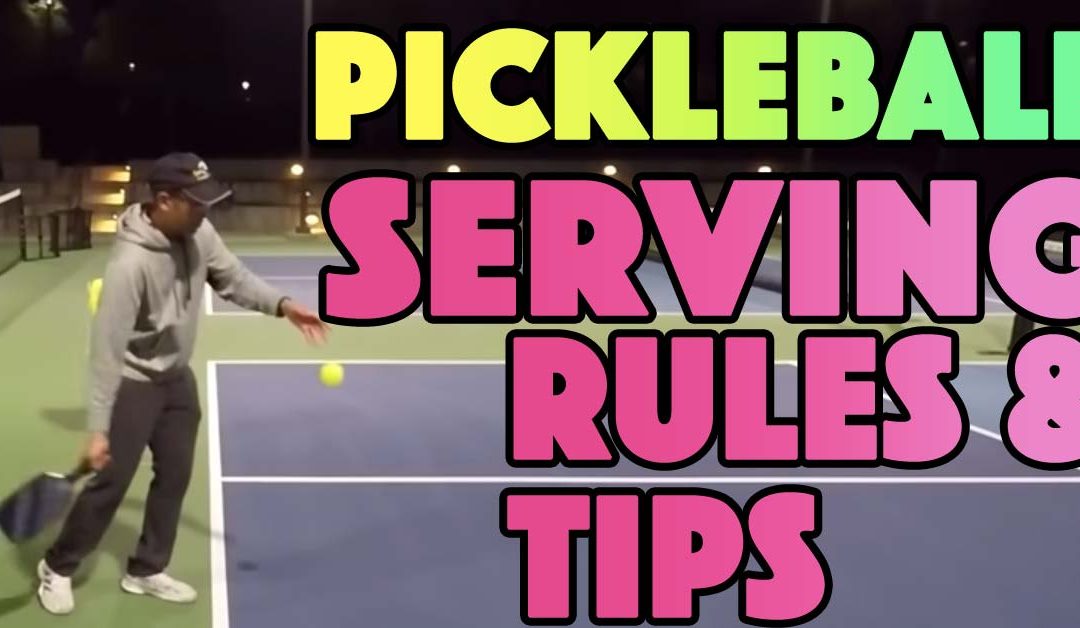Are you having trouble getting up to the net especially when you’re getting really low shots down at your knees? If so, this article is made just for you.
Your’e going to want to learn, understand and implement the reset shot. This is the shot used by all high level players to get out of jammed and low contacts. Having command of this shot is arguably the single biggest differentiator between lower level players and higher level players.
Reset shot: A soft shot hit in the area that typically ranges from approximately mid-court (the transition zone) up to the non-volley zone (NVZ) line when you have been attacked by your opponent with an offensive shot. The term “reset” refers to the fact that you are trying to reset the point for yourself from defense to neutral and take away the advantage your opponents currently have in the point while they are on offense.
We’ll dive deeper on how and why to hit this shot as well as cover how you can develop this shot and implement it into your game.
Many players that are not having the success that they want in their pickleball games are probably doing several things that are a contributing factor to their negative results.
However, among those things there is often one glaring mistake that we see coming up over and over again. It is a consistent culprit holding many players back from achieving the level they desire.
What is it?
Hitting hard on shots that they contact low.
This is a major mistake because you’re giving your opponent exactly what they want while they’re already winning the ground war because they’re up at the NVZ line and you’re not.
You’re feeding them with an opportunity to beat you. They simply have to keep knocking that ball down hard and low at you or low and past you. If they can handle the pace, and most higher level players can, they run away with the win easily.

In this type of scenario, most of the time, you’re going to want to reset that ball because it’s the smarter shot.
You want to keep that ball in play and take the wind out of their sails at the same time by making them have a low contact point on their next shot as well.
It won’t be offensive, like what they have been doing to you, but it will at least get you out of trouble.
When you hit your low contact ball back hard, it just puts fuel on the fire and you will usually end up deeper and deeper in trouble as they repeatedly attack you.
When To Reset vs. When To Hit A Swinging Volley
Let’s say you’re making your way from the baseline to the non-volley zone and you’ve hit your third shot a bit higher than you would have liked.
You are in the middle of the transition zone – so what do you do from here?
What’s the smart shot?
If the ball comes back to you on the higher side and you can hit it at a level trajectory or hit down on it and it will get over the net when hitting it that way, that’s a great time to take a swinging volley and drive it hard. Chances are, your opponent didn’t mean to do that so you should punish them for their mistake.
If your drive works out well, meaning you received another high ball then go ahead and keep attacking. This is an ideal situation to stay aggressive.
The more advanced your opponent, the more skillfully they will be able to prevent you from getting high contacts.
When you are in the transition zone, a skillful opponent will be striving to get you to make contact with the ball at knee level or below.
These shots are harder to deal with but not impossible. This is when you reach into you bag of shots and pull out a reset shot.
The reset shot is actually quite a simple shot because you barely swing, you are really just blocking the ball.
The challenge lies in finding the right grip pressure, the right paddle face angle and the right amount of push to use (or no push at all).
This will all differ depending on how hard your opponent hit it, how low it is, how much you have to stretch, how much spin they have put on it and what kind of spin, and if you volley it or let it bounce.
It’s a simple shot but that doesn’t make it easy. You have to get all these elements just right and there’s a lot to take in to account in a short amount of time because it’s coming fast.
You have to hit with a feathery touch that travels in a soft arc and drops gently over the net and forces them into a low contact in order to complete the “reset” of the point and get yourself out of this momentary defensive jam.
Because this is such an important shot, and because it involves so much precision and nuance, you’re going to want to spend a great deal of time working on it in order to master it.
Your whole game will elevate when you gain command of this shot.
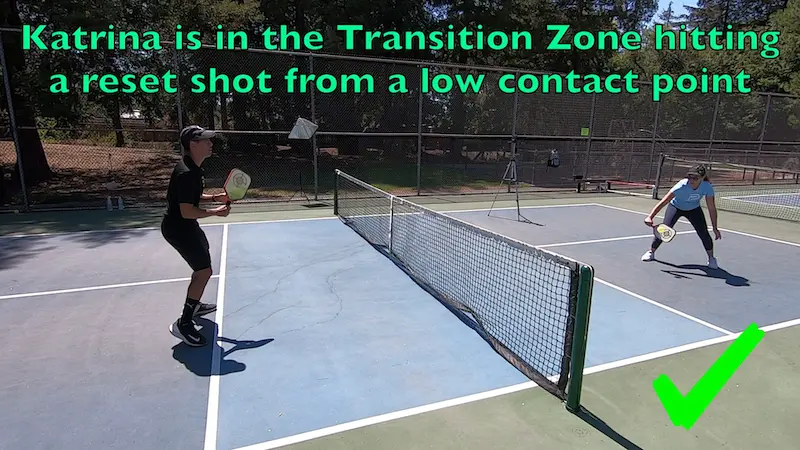
How To Develop The Reset Shot
In this practice scenario, one player will be up at the NVZ line, while the the other player starts at the baseline. The NVZ line player feeds to start the drill and the baseline player hits a third shot drop.
They assess the quality of their drop and move in accordingly.
If they hit it well, meaning it looks like their shot is going to force a low contact for the NVZ line player, they can move in a bit more and close more of the gap as they make their way towards the NVZ line.
If it doesn’t look like it’s necessarily going to force a low contact then they should move in less and get ready to have to dig the next one out if necessary.
In either case, they should move in where appropriate and hit their split step as their drilling partner is making contact with the ball.
Your drilling partner at the NVZ line should be trying to press you as much as possible by hitting it at your feet or giving you low stretch contacts. Not necessarily putting the ball away, but making difficult shots for you.
You can both agree that they can hit a winner if the opportunity is there or you can agree that they should just try to make things tough for you but not necessarily go for winners.
The goal is that you get a lot of well earned repetitions digging out low contacts and successfully making your way up to the NVZ line.
You can stop the drill once you make it up there and start back over at the baseline or your drilling partner can move back to the baseline and take a turn as the “reset shot” player.
Balance is Paramount In The Transition Zone
You don’t want to be in motion when you’re drilling partner at the NVZ line is hitting because you can’t be sure what’s about to happen. You’ll want to center yourself and your balance so you can move in any direction as needed.
If you’re in motion and they hit it towards the place you’re moving away from then that’s going to spell trouble.
That’s why you always want to be sure to hit your split step as you work up to the NVZ line so you don’t caught in a bad situation that could’ve been avoided.
Chances are, if you hit a good drop, you’ll have an easier play on the next shot and if you hit it poorly then you will have to defend and block.
BUT….that is not necessarily true depending on how good your opponent is.
Even if they’re quite a good player, they could mess up an easier shot or hit an amazing shot off of a shot you hit rather well.
You just don’t know.
Hope for the best, plan for what’s likely, and deal with what comes.
10 Key Techniques For A Strong Reset
Some key things that you’re going to want to focus on when you’re the one dealing with the low contact in the transition zone is:
- A contact point out in front of your body
- A firm grip pressure but loose enough to allow your paddle and hand to absorb some pace from the shot in order to send it back as slow as is needed.
- A paddle face angle that you keep relatively stable. How open it is will depend on the height of the contact and how far back you are.
- As much push as is needed if you’re further back in the court or if it’s an off speed attack (not full speed).
- As little push as is needed if you’re close to the NVZ line or if it’s a full speed attack.
- Virtually zero wrist or elbow action. Remember you’re blocking and not swinging.
- Virtually zero backswing.
- A low center of gravity. Get low with your legs and be in somewhat of a squatted position in your preparation to deal with that low contact
- To have the paddle down lower than you normally would. This is due to the fact that you know they will be targeting your lower legs or targeting low and away from you with the intention of forcing you to reach.
- Stable footing and balance so that you’re free to move in any direction. DO NOT be in motion at the time of their contact. You will pay for that mistake.
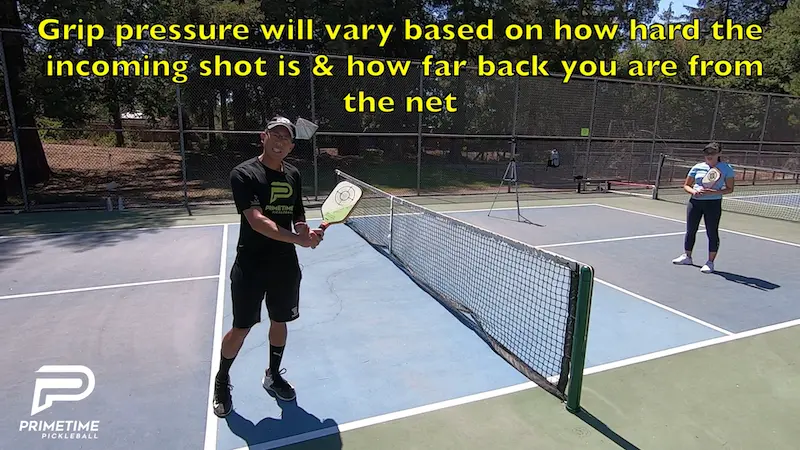
Final Thoughts
If you’re doing a good job as the player advancing in from the back court then your shots will be dropping over the net and your drilling partner at the NVZ line won’t be able to do much with them because their contact points will be consistently to low and the net will be too much in the way for them to be offensive with their shots.
This is why you want to be hitting these reset shots, so you can routinely make your way up to the kitchen behind them and neutralize any advantage your opponent may have had up until that point.
It’s a shot that all the top players hit routinely and well. Every single match you’ll see them hitting this shot.
Success leaves clues so you’d be wise to get out there and practice this shot often. It will make all the difference between you leveling up you game or not. Every advanced player must have this shot in their toolbox to be considered an advanced player. There’s no way around it so get out there and get to work.


